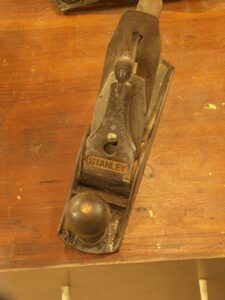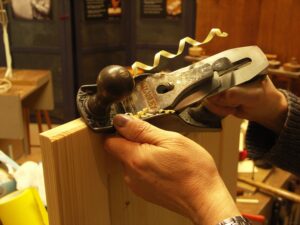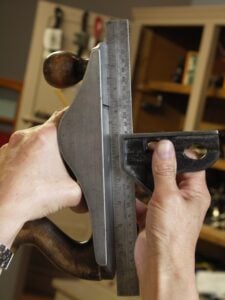#4 hand smoothers continued
The best plane for most people of a small stature, and I find this so for most women. new woodworkers, men not used to manual work and young woodworkers, is a #4 Stanley or Record plane. They are the lightest of all planes and they not only work, but they work well with no retrofitting straight off the cuff. they are also the cheapest bench planes available and will cater to about 80-90% of your planing needs, believe me.

Your eBay #4 arrived in it’s cornflake box wrapper reinforced with gaffer (duck US) tape and you just pulled it from its confinement. You could just as easily have found it in a car-boot sale (UK), flea market, garage sale (US) or the cellar of your dad’s house. It’s all pretty much of a muchness. Twiddling the adjustments, feeling the handle and so on usually follows to see if all the functional parts are working and then there’s the visual check that everything is there with no cracks in the body casting or broken handle. What happens next?

First of all I would like to tell all plane owners that the Stanley or Record #4 will plane anything a rich man’s plane will and is equal to every task within its design range of surface smoothing and levelling adjacent component parts on projects such as doors, window frames, box rims and just about everything else. There is no shame in putting a basic no-frills #4 alongside the best of the best. In fact, this #4 may do more than the heavyweights and you may find that after fundamental fettling you will reach for this over any other. That said, when you get to the longer planes, jack and above, I think wider and heavier planes, not too heavy, come into their own. Especially bevel ups in some cases. Secondly; how may of you know that just as dead sharp saws need sharpening every few weeks, dead flat soles b]need flattening from time to time too. If, fo instance you use a plane such as a jack plane for planing along the lengths of doors, edge joining and so on, you will gradually wear a shallow channel along the length of the plane because the wood you plane will usually be narrower than the plane. That being so, the sole will need working flat again.
What’s the next step?
I see that most people like myself focus heavily on the flatness of the sole of the plane and in some measure this is somewhat important, but I cannot recall any plane that I bought that didn’t take good shavings of straight off the bat once the plane was sharpened, set and adjusted properly. The trouble occurs when you come to realise that the adjustments on the plane all correspond to the sole. That being the case, it stands to reason that whatever registers to the face f the sole should have a standard commensurate to all other adjustments and that’s why we focus on this face alone so critically. And usually first.

Regardless of sharpness and set, the planes sole determines the final shape of the wood being planed. Think about it. If the sole is convex in any direction it will create an exact opposite on the wood. So a convex sole creates a hollow on the wood being planed and a concave sole creates a round. Flatness then is critical to the work in hand. One problem seldom discussed and one I see regularly occurring is that all cast metal planes change according to temperature. I take my planes from the shop to North America and the sole is altered albeit only fractionally. Because I use it in my everyday work as a furniture maker I sense that change. The smaller the plane the less evident the change, but change there is. That being so, why flatten the sole. Most woodworkers are in the same environment so their planes stay in the same workshop. That’s the same for me, as the planes I use in the workshop don’t usually travel with me. I have a travelling kit I keep for demonstrating because of convenience and safety and airport security; I don’t want to lose my personal long-owned planes to lost luggage at airports. So far that’s never happened. So as the environment in my Penrhyn Castle workshop is extremely constant, my tools remain in the same shape. Because the Castle is effectively museum status, we use dehumidification to control humidity levels so my workshop is at a constant temperature with exact levels of controlled humidity. Quite rare for we woodworkers and a dream for a furniture maker.
Soles and flatness
It may surprise you to know that whereas flat soles are important wherever possible, it is not the absolute most plane touting salespeople say you need. In fact, as I said, you can make any plane do what you want it to do if you know your plane and use it often enough.
Retroing your dead-flat plane soles
Whereas with rounded soles you may well need to flatten the sole, one great advantage with older planes second hand from whatever source is that the perimeter areas adjacent to the long edges, the heel and toe of the plane, are actually gently rounded, so they feather in to the main flat of the sole and this is great for we woodworkers because when we level adjacent surface or move across the flat face of the wide boards we plane, the plane very gently rises to the occasion and allows a perfect transition before levelling the highs we need to get to. So, when you flatten the sole of whatever plane, I suggest you focus on the main central area and don’t worry about the periphery. That will indeed ease the burden of flattening and takes in many cases 50% percent of the work without compromising the result.
On new, better-engineered planes, the soles are always dead flat right up to the corners where the engineers see removing the arris as adequate. Not being woodworkers they don’t realise that we woodworkers want the same rounded periphery we get through wear on older planes. To round this outer area tape a rule along its length adjacent to the abrasive paper and move the plane along so that the opposite edge is chamfered a little. It doesn’t need to be much. Repeat on the opposite side and then the two ends. File off the half moon heel so that on the backstroke the heel doesn’t chew up the rim adjacent to the part you are planning.
Levelling the sole of a plane is also called lapping
Start off on a flat slab. Not always there and ready to go I know, but I go to the Home depot or B&Q, pick up a square and check the tiles for flatness. I have always managed to find one that is flat after a few tests and so I buy a flat 12” square tile. Other than that you can use a piece of thick float glass.
Any abrasive paper will remove steel from the casting quite quickly. It is up to you how much you want to polish the surface after you have flattened it. It is not necessary to go more than 250-grit, but you can if you wish.
This step levels and flattens. On old planes the peripheral areas I have talked of will be rounded so leave them rounded, as this is exactly what you want


G’day Paul, comeing from the school of the right tool for the right job. It has always confused me as I observed to you useing wood purposed sand paper instead of emery paper, whilst fetteling your planes. Not a question of importance, just a long term bug bear question, Ta for all you for so many, cheers Peter
Not sure if this is a question or not but I have found that abrasives used for wood to be more aggressive and less expensive than emery paper and I don’t have to buy it in special. Hope that helps.
yes it was a question, and thanks for the answer, appriciated Peter